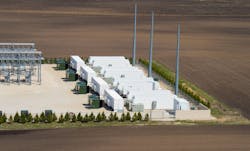TEP Building Energy Storage Systems
Tucson Electric Power (TEP) is enhancing the resiliency of the local electric grid with three innovative energy storage facilities.
A subsidiary of NextEra Energy Resources of Juno Beach, Fla., recently completed construction of a 10-MW lithium nickel-manganese-cobalt energy storage system at a TEP substation near Interstate 10 and West Grant Road. The system is now helping to maintain reliable service for customers during periods of high energy demand by supporting stable voltage.
Meanwhile, Chicago-based E.ON Climate & Renewables is building a 10-MW lithium titanate oxide storage facility and an accompanying 2-MW solar array at the UA Tech Park southeast of Tucson. The systems are expected to be completed in the spring.
Energy storage systems can boost power output levels more quickly than conventional generating resources. Energy storage systems can be used to maintain the required balance between energy demand and supply, allowing utilities like TEP to avoid the use of more expensive generating resources while expanding renewable resources. The systems also could provide up to 5 MW of power for approximately an hour in the event of an outage.
NextEra Energy Resources and E.ON submitted favorable bids that allowed construction of both projects for less than the original estimated cost to build a single 10 MW system. Both projects will be developed under 10-year contracts with performance agreements to protect customers and the company from financial risks associated with investing in new technologies. More than 20 qualified vendors submitted concepts for energy storage systems after TEP issued a request for proposals in June 2015.
TEP also is participating in a two-year research and development project with Chicago-based IHI, Inc. Energy Storage (IHI) to study how efficient use of battery energy storage systems can improve electric reliability in Arizona’s hot, dry climate.
IHI constructed a 1 MW lithium ion energy storage system at the site of TEP’s Prairie Fire Solar Array, a 5 MW system located near Interstate 10 and East Valencia Road. IHI will test its proprietary ESWare® planning and control software while working with TEP to develop efficient control strategies for energy storage systems. This will give TEP opportunities to identify when and where the installation of additional energy storage systems would be most beneficial. The IHI system will be charged with energy generated by TEP’s solar array.
Energy storage systems could help ensure the quality and reliability of electric service as TEP and other utilities add intermittent wind and solar resources to the grid. TEP plans to add 800 MW of new renewable capacity by the end of 2030, boosting its total renewable energy portfolio to approximately 1,200 MW.
